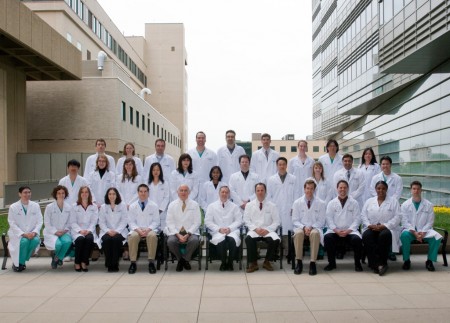 The Johns Hopkins Department of Pathology is currently home to 34 residents, each with his or her own research interests and career goals. These 34 residents include 19 men and 15 women representing medical school and graduate training in the United States, China, Japan, Taiwan, UK, and Pakistan.
The Johns Hopkins Department of Pathology is currently home to 34 residents, each with his or her own research interests and career goals. These 34 residents include 19 men and 15 women representing medical school and graduate training in the United States, China, Japan, Taiwan, UK, and Pakistan.
But some of you may wonder — what is residency exactly? Residency is specialized training that a physician receives after he or she completes medical school. Some come to residency after completing additional graduate work beyond an MD, most frequently a PhD. In fact, thirteen of 34 current residents have earned PhDs. Other residents have earned master’s degrees in a variety of academic disciplines.
Depending on the specialty a physician chooses, a residency can be as few as 3 years, or as many as 7 years. The combined anatomic and clinical pathology (AP/CP) training program is 4 years in length, while either AP or CP training is limited to 3 years. Another option, the combined anatomic and neuropathology (AP/NP) training program is also 4 years in length.
The Department of Pathology at Johns Hopkins provides residency training in anatomic pathology (AP) and clinical pathology (CP), either combined or individually. Residents enrolled in the training program complete rotations in the clinical pathology disciplines of clinical chemistry, cytogenetics, diagnostic immunology, hematology/coagulation, transfusion medicine, medical microbiology, molecular diagnostics, and laboratory management. Rotations in anatomic pathology include autopsy, forensic pathology, surgical pathology, gynecologic/pediatric pathology, cytopathology, and gastrointestinal/liver pathology.
Outside of our required rotations, residents participate in Pathology Department Grand Rounds, weekly didactic conferences, journal clubs, and independent research projects. Many residents’ projects have resulted in poster and oral presentations at national and international meetings, as well as countless publications in various academic journals.
When we’re not hard at work, the residents often enjoy socializing with each other and their families. Intern welcome dinners, picnics, outings to Orioles games, and a consistent stream of baby showers are just some of the ways the residents make time for each other outside of the Hospital. In short, the residents have established a support system for each other, both professionally and personally.
Julie Katz Karp, M.D.
Co-Chief Resident